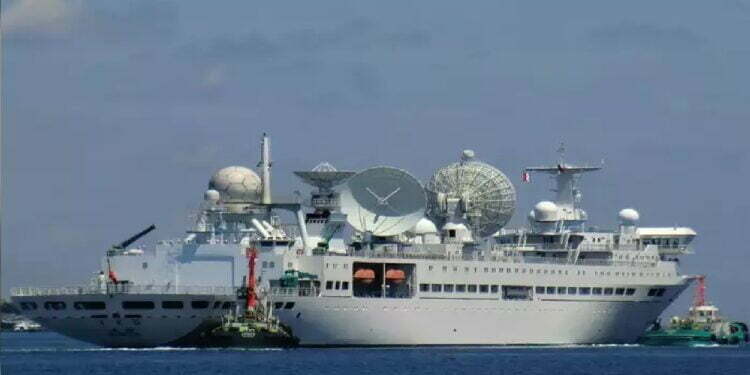A Chinese “spy ship” that is headed to Sri Lanka and will arrive at its Hambantota port around August 11 is being keenly watched by India. The ship’s visit to the port in Sri Lanka occurs at a time when the nation is grappling with a terrible economic crisis, and it is said that India has already voiced its vocal opposition to the ship’s arrival.

The “Yuan Wang 5,” a Chinese research and survey vessel, is on its way to Hambantota, a crucial deep-sea port that was built mostly with Beijing financing.
Satellite, rocket, and intercontinental ballistic missile (ICBM) launches are monitored by ships of the “Yuan Wang” class. About seven of these tracking ships, capable of travelling over the Pacific, Atlantic, and Indian seas, are owned by China. Beijing’s land-based tracking stations are supplemented by the ships.
The PLA’s Strategic Support Force (SSF), which is “a theatre command-level organisation established to centralise the PLA’s strategic space, cyber, electronic, information, communications, and psychological warfare missions and capabilities,” is said to be in charge of operating these space support ships.
China’s Jiangnan Shipyard produced the “Yuan Wang 5,” which went into service in September 2007. Modern tracking equipment is onboard this 222-meter-long, 25.2-meter-wide vessel for transoceanic aerospace surveillance.
China’s “Long March 5B” rocket was launched during its most recent observation mission. Additionally, it recently participated in the maritime observation of the launch of the first lab module for China’s Tiangong space station.
The “Yuan Wang 5” is scheduled to arrive at Hambantota port on August 11 for a week and is expected to depart on August 17 after being restocked, according to the Belt and Road Initiative Sri Lanka (BRISL).
Through August and September, “The Yuan Wang 5 will execute satellite control and research monitoring of China’s satellites in the North Western section of the Indian Ocean region,” according to BRISL.
“Yuan Wang 5’s visit to Hambantota Port would be a fantastic chance for Sri Lanka and the regional developing countries to study and develop their own space projects,” it was said.
Several ports in Kerala, Tamil Nadu, and Andhra Pradesh may be under China’s radar thanks to the Yuan Wang 5, a powerful monitoring vessel with an estimated 750 km aerial reach. According to reports, numerous important sites in South India may be at danger of being spied on.
Speaking on the situation last week, Arindam Bagchi, a spokesman for the Ministry of External Affairs, had stated: “We are aware of rumours of a potential visit by this vessel to Hambantota in August…
The government takes all necessary precautions to protect India’s security and economic interests, and it constantly monitors any development that might have an impact on them.
China’s foreign ministry responded by saying in a statement obtained by Reuters that it “hopes the relevant parties would observe and report on China’s marine scientific research efforts appropriately and desist from interfering with typical and legal maritime activities.”
Hambantota, the second-largest port in Sri Lanka, is located along the route that links Southeast Asia with Africa and West Asia. It is a significant station on China’s Belt and Road Initiative. China has contributed significantly to its expansion, and in 2017 Colombo transferred its majority ownership to a Chinese company after failing to pay off the growing debt.
India and the US have often expressed worry that Chinese control of this port, which might serve as a centre for the PLA Navy, may undermine their interests in the Indian Ocean. While pointing out that it perfectly fits China’s “string of pearls” strategy to encircle India in the Indian Ocean by expanding its land and marine footprint, security analysts in India have frequently questioned its economic sustainability.
The closeness of Hambantota to India may provide the Chinese navy with the opportunity for the long-desired maritime flex against India.
